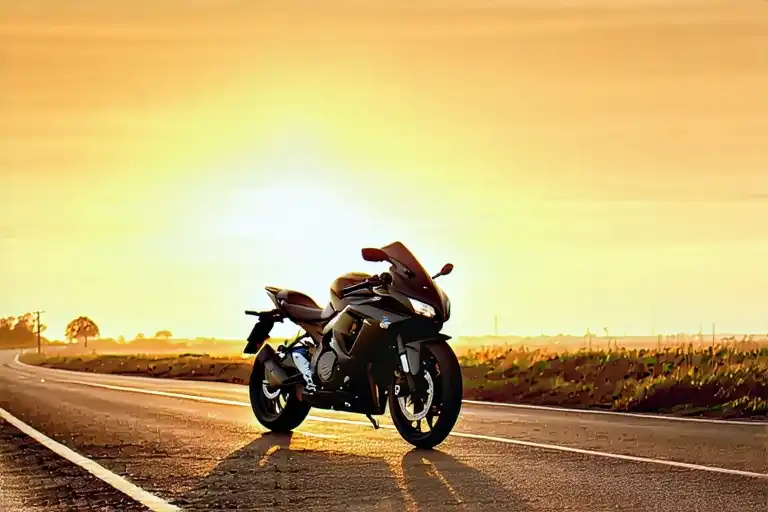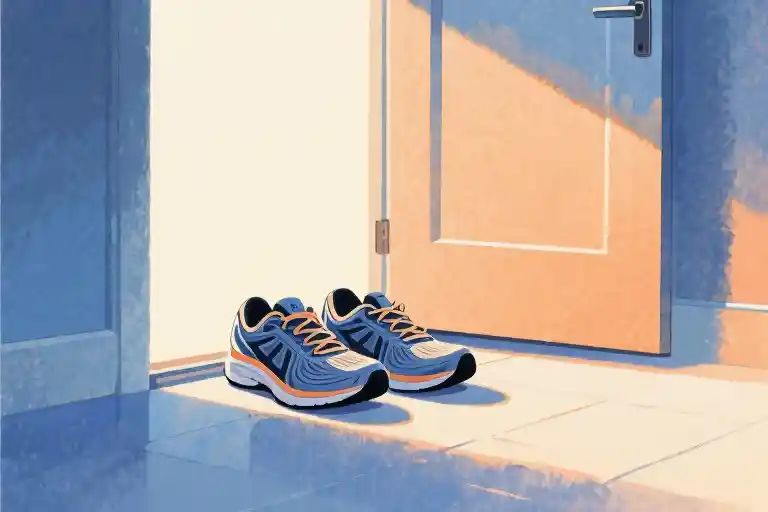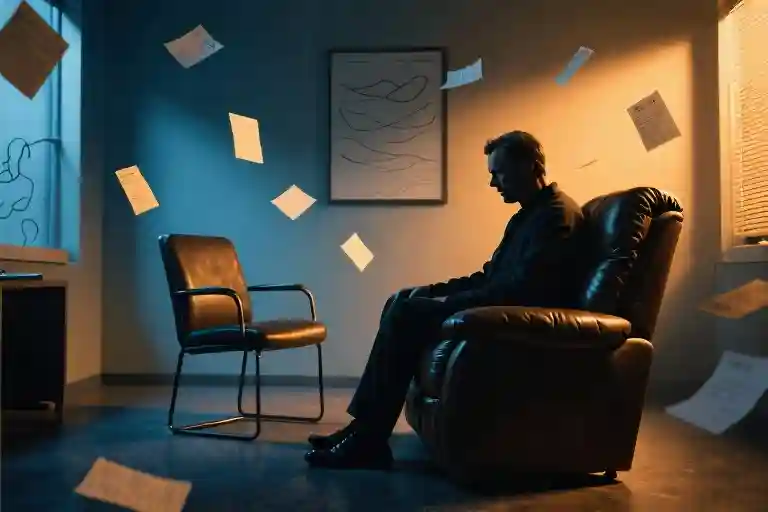Me? A motorcyclist? The idea would’ve made me laugh nervously just a few years ago. There I stood in that dealership – a forty-something woman with ice-cold hands clutching a wad of cash, staring at a machine that might as well have been a spaceship. My reflection in the shiny black paint showed someone who didn’t belong here, someone whose life had become smaller than she’d ever imagined.
Anxiety had been my constant companion since childhood, that whispering voice insisting I wasn’t capable. It followed me through dead-end jobs, through raising a neurodivergent child alone, through years of chronic fatigue that left me emotionally numb. When my marriage ended, the open road ahead didn’t feel like freedom – it stretched out like an empty highway at 3am, all shadows and loneliness.
Traditional therapy helped in fragments, but often left me feeling more broken. Well-meaning friends would say “you’re so strong” while I secretly cataloged my failures. I needed something radical, something that would force me to prove my own strength to myself. Not another self-help book or medication adjustment – I needed concrete evidence I could still learn, still grow, still surprise myself.
Then came the motorcycle. Or rather, then I came to the motorcycle – drawn by some impulse I still can’t fully explain. Maybe it was the memory of my father’s old Triumph photos, maybe just the sheer absurdity of the idea. That first visit to the dealership plays like a comedy in my mind now: the salesman’s raised eyebrow when I asked about the green Ninja (“Do you have it in black?”), my trembling hands signing paperwork for a machine I couldn’t operate, the surreal moment when they handed me the keys to my own anxiety antidote.
Motorcycling found me at exactly the right moment. Not when I was strong and confident, but when I was too exhausted to keep pretending. That 125cc engine would become my unlikely therapist, my meditation guide, and eventually, my passport to a community I never knew I needed. What began as a desperate grab for control became the most empowering relationship of my life – the kind that teaches you to trust yourself again, one shaky gear change at a time.
There’s something alchemical that happens when women, particularly those of us past some imaginary expiration date, claim space in traditionally male domains. The motorcycle became my moving rebellion against every “you can’t” and “you shouldn’t” I’d internalized. Those first wobbly rides around my neighborhood, with neighbors peering through curtains and my own heartbeat louder than the engine, became sacred acts of self-reclamation. Every stalled engine was proof I was trying. Every successful turn was evidence I could still learn.
What surprised me most wasn’t the physical challenge (though believe me, clutching a cold metal frame with arthritic hands is no joke), but how quickly riding demanded my full presence. Anxiety thrives in the past and future, but a motorcycle insists on now – the texture of the road beneath you, the precise pressure needed on the clutch, the dance between throttle and balance. In those early rides, I discovered something profound: it’s impossible to spiral about your failures when you’re wholly focused on not dropping your bike at a stoplight.
Research would later confirm what my body already knew. Studies from Harvard Medical School show that activities requiring “focused attention on bodily movements” – like riding – create neurological changes similar to meditation. That 125cc engine became my mindfulness bell, the vibration through the handlebars a constant reminder to stay grounded in the present. Where therapy sessions sometimes left me emotionally raw, riding left me physically spent but mentally clear – the good kind of tired that comes from using all of yourself.
Most unexpectedly, the motorcycle led me to my people. Not the leather-clad stereotypes of movies, but a wildly diverse tribe of humans who understood about using speed to outrun darkness. There was Paul from Make Your MARK who showed up with tools when I couldn’t figure out my chain maintenance. The women at Bibury Bike Meet who cheered my parking lot victories. The charity riders who turned engines into instruments of change. With every connection, that old narrative of “I’m alone in this” chipped away a little more.
This journey hasn’t erased my anxiety – some days it still sits behind me like an unwanted passenger. But now I have tools, I have proof, and most importantly, I have a two-wheeled metaphor that reminds me: forward motion creates its own stability. You don’t have to be fearless to ride. You just have to want freedom more than you fear falling.
Maybe your healing won’t come on a motorcycle. But I promise it’s waiting somewhere unexpected, in some activity that will make your friends say “You? Really?” with that same delightful skepticism I once faced. The path back to yourself often looks nothing like you imagined – mine just happens to have handlebars and a very loud hair-dryer engine.
The Purchase: An Absurd Self-Redemption
Standing beside that intimidating machine, I could almost hear the universe laughing at me. A middle-aged woman with anxiety written into her bones, staring down a Ninja motorcycle in the brightest shade of green imaginable. The sales assistant probably thought I’d wandered into the wrong shop—maybe looking for gardening tools rather than 125cc of freedom.
That Kermit-the-Frog-colored bike became the unlikely symbol of my rebellion against everything that had held me back. The absurdity wasn’t lost on me as I pointed to it and declared, ‘I’ll have one of these… if it’s black.’ My voice didn’t even quaver—a small miracle considering my palms were sweating enough to hydrate a small desert.
The Financial Recklessness of Healing
Let’s be clear: this wasn’t a sensible decision. My bank account whimpered in protest, still recovering from divorce settlements and single-parent expenses. The rational part of my brain (the part that usually won every argument) kept screaming that I didn’t know how to ride a geared bike. My only experience? A half-day CBT course on an automatic scooter six months prior, where I’d nearly taken out an entire row of traffic cones.
Yet there I stood, signing paperwork with hands that shook slightly—not from fear, but from something far more dangerous: hope. The kind of hope that makes you do foolish, beautiful things. The kind that whispers ‘what if’ loud enough to drown out years of ‘you can’t.’
The Psychology of Impulse Purchases
What makes a clinically anxious woman walk into a motorcycle dealership and commit financial and physical recklessness? It wasn’t midlife crisis—I couldn’t afford the cliché. This was something deeper, a perfect storm of:
- Professional stagnation: Years of unfulfilling jobs that left no mark
- Parental exhaustion: Raising a neurodivergent child without a support network
- Medical baggage: Myalgic encephalomyelitis (ME) and depression tag-teaming my energy levels
- Romantic rubble: The ghost of a twenty-year marriage haunting my empty house
Motorcycling represented the opposite of all that weight. On two wheels, there would be no labels—not ‘anxious,’ not ‘divorced,’ not ‘exhausted mom.’ Just wind speed and the immediate present. The sales receipt might as well have read: One (1) Ticket to Becoming Someone Else.
First Contact With Freedom
When the black Ninja finally arrived (blessedly not green), reality hit like a cold splash of petrol. There it sat in my driveway—all gleaming menace and coiled potential. My neighbors’ curtains twitched with interest. What was the anxious woman from number 42 doing with a motorcycle? Had she finally cracked?
I ran my fingers along the cool metal, feeling the vibrations of possibility. The clutch lever resisted slightly under my touch, a physical manifestation of the challenge ahead. Somewhere beneath the terror, a spark ignited—the same feeling I’d had as a child staring at the highest diving board at the local pool. The knowledge that stepping off the edge would change everything.
That night, I lay awake not with my usual anxiety spirals, but with something unfamiliar: anticipation. The bike waited outside like a silent promise. I hadn’t ridden it yet. Didn’t know if I could. But for the first time in years, the voice in my head wasn’t whispering you’ll fail. It was asking, what happens next?
The Beginner’s 100 Ways to Fail (And Why That’s Perfect)
Standing in my driveway that first morning, I realized motorcycle lessons don’t come with dignity included. My shiny black Ninja might as well have been a spaceship – all levers, pedals, and mysterious buttons blinking at me like some mechanical pop quiz. The neighbors’ curtains twitched with the subtlety of Broadway spotlights.
The Great Clutch Catastrophe
That first attempt at moving could’ve been a slapstick routine. Left hand squeezing the clutch (“Like wringing out a wet towel,” the manual said – helpful), right foot hunting for the gear lever (why does it move both up AND down?), all while trying to remember whether to twist or push the throttle. The engine stalled with a cough that sounded suspiciously like laughter. Then again. And again.
My knees locked like rusted hinges. The bike lurched forward exactly three feet before I instinctively grabbed both brakes, nearly headbutting the handlebars. Through my helmet’s fogged visor, I could see Mrs. Henderson from number 42 frozen mid-garden-watering, hose dangling like her jaw.
The 3 MPH Victory Lap
Then came the miracle moment – the clutch whispered instead of shouted, the throttle stopped being a light switch and became a dimmer. Suddenly, I was moving. Not fast – my speedometer proudly displayed 3 mph, slower than walking pace. But I was riding. Actually riding.
The vibration traveled up through the seat, through my spine, settling somewhere behind my ribs where anxiety usually lived. For those wobbling, glorious seconds down to the end of our cul-de-sac, there was no room for intrusive thoughts – just the immediate calculus of balance, throttle, and not face-planting on Mrs. Henderson’s prize petunias.
Why Beginner Struggles Are the Best Therapy
Looking back, those clumsy first attempts taught me more than any perfect ride could:
- Failure is mandatory – Each stall burned away my perfectionism. You can’t be anxious and focused on not dropping the bike simultaneously.
- Progress measures differently – That “3 mph victory” mattered more than any highway speed later. Small wins rebuild confidence like compound interest.
- The body remembers before the brain does – Muscle memory eventually overrides panic. Now when anxiety hits, I still hear that clutch finding its friction zone.
Research from the University of California shows that learning complex motor skills (like operating a motorcycle) creates new neural pathways that can literally rewire stress responses. My 125cc hairdryer-sounding bike became a moving meditation mat.
Your Turn in the Spotlight
If you’re hesitating because you imagine seasoned riders judging your wobbly starts, know this: every biker remembers their first drops, stalls, and comically slow turns. The motorcycle community celebrates beginners because we see ourselves in them. Those curtain-twitching neighbors? Half later admitted they were jealous.
Next time we’ll talk about transforming “Oh god, a hill!” into “I own this incline” – complete with the physics-defying magic of countersteering. Until then, remember: every expert was once a beginner who didn’t quit after the hundredth stall. Your 3 mph victory is coming.
Why Motorcycling Works Better Than Therapy
That first shaky ride down my street at three miles per hour did more for my mental health than six months of cognitive behavioral therapy ever could. There’s something alchemical that happens when you combine vibration, velocity and vulnerability – a perfect storm for breaking through emotional barriers that talk therapy often circles around.
The Science of Two-Wheeled Mindfulness
Neurologists call it “involuntary attention capture” – that state where your brain has no choice but to focus completely on the present moment. On a motorcycle, survival demands it. Unlike meditation where stray thoughts drift through like clouds, riding forces laser focus through physical feedback: the clutch’s friction zone beneath your fingers, the subtle weight shift needed for cornering, the wind pushing against your chest like a persistent friend keeping you upright.
Harvard studies show motorcycle riding produces brainwave patterns similar to experienced meditators – increased theta waves in the prefrontal cortex that correlate with reduced anxiety. But where meditation requires disciplined practice, riding achieves this state organically. My 125cc Ninja became what researchers call an “attentional anchor,” its constant hum (admittedly hairdryer-like) providing the rhythmic baseline my chaotic thoughts could finally sync with.
The Paradox of Physical Discomfort
There’s an unexpected healing power in minor suffering. Ice-cold fingers gripping handlebars, the ache in your thighs after hours in the saddle – these physical sensations create what psychologists call “benign masochism.” The discomfort is real but non-threatening, teaching your nervous system that you can endure hard things while remaining safe. For someone whose anxiety had turned everyday situations into perceived threats, this recalibration was revolutionary.
My therapist had encouraged “grounding techniques” – naming five things you can see, four you can touch. Riding made this automatic: the vibration through footpegs (1), wind pressure on my shoulders (2), the scent of cut grass mixing with petrol (3), the taste of rain on my visor (4), the engine’s pitch changing with elevation (5). Sensory overload becomes sensory therapy when your body remembers how to interpret signals correctly.
Flow State Versus Fight-or-Flight
Anxiety disorders trap sufferers in a perpetual fight-or-flight response. Riding short-circuits this by inducing what positive psychologists call “flow state” – that sweet spot where challenge meets skill level. Navigating a roundabout requires exactly enough attention to crowd out anxious thoughts, but not so much as to trigger panic. It’s cognitive behavioral therapy in motion: exposure to controlled risks that rebuild your tolerance for uncertainty.
When researchers at UCLA hooked up motorcyclists to EEG machines, they found riding decreased stress hormones by 28% compared to car drivers. The combination of fresh air, focused attention and mild physical exertion creates what I call “active meditation” – mindfulness you can’t fail at because the bike won’t let you zone out completely.
The Body Keeps the Score Differently on Two Wheels
Trauma expert Bessel van der Kolk wrote about how trauma gets “stuck” in the body. Riding helped me rewrite those somatic memories through new physical experiences. Where therapy had me talking about past events, motorcycling created present-moment victories my nervous system could log as evidence: “See? You handled that gravel patch. You leaned through that curve. You’re competent here.”
There’s an undeniable empowerment in mastering machinery that initially intimidated you. Each successful ride deposited confidence coins in my emotional piggy bank – small but tangible proof I could overcome challenges. Unlike abstract therapeutic concepts, these victories were measurable in miles conquered, skills acquired, fears faced. The bike became both mirror and metric, reflecting back capacities my anxiety had convinced me I’d lost.
Why This Beats the Couch
Traditional therapy often happens in sterile rooms where your worst moments get examined like insects under glass. Healing on a motorcycle happens in the wild, with your whole body engaged in the process. Where talk therapy separates mind from body, riding reintegrates them – your thoughts direct your muscles which control the machine which responds to the road in an endless feedback loop of presence.
That’s not to dismiss professional mental health care. But for those of us who found traditional approaches limiting, motorcycling offers complementary healing: therapy you don’t schedule, breakthroughs that come not from analysis but from doing, progress measured not in insights gained but in roads traveled. Sometimes movement itself is the medicine.
Finding My “Steel Tribe”
That photo from Bibury Bike Meet in May 2024 still makes me smile every time I see it. There I am — the blonde squished happily between twenty leather-clad strangers who didn’t feel like strangers at all. Six months earlier, I wouldn’t have believed I’d ever belong in such a photo, let alone have the confidence to ride seventy miles to get there.
The Unexpected Welcome
When I first pulled into the meetup location, my 125cc engine humming like an overworked hairdryer amidst the throaty roars of bigger bikes, I nearly turned around. That old whisper of “You don’t belong here” started up again. But then Paul from Make Your MARK spotted me — this nervous woman with death-grip handlebars — and walked over with two coffees. “You made it!” he said, as if we’d known each other for years. That’s when I understood what makes the motorcycle community different.
In this tribe:
- No one cares if your bike could fit in someone’s saddlebag
- Everyone remembers their own shaky first ride
- The only prerequisite is loving the feel of two wheels beneath you
More Than Miles
The real magic happened during the charity ride for Dave’s Defib. Fifty of us — men and women, young retirees and young-at-heart, shiny new bikes and well-loved classics — rode together to fund life-saving AED units for bikers. There’s something about riding side-by-side for a cause that dissolves barriers faster than anything I’ve experienced. By the third rest stop, we were swapping stories not just about carburetors, but about:
- Divorces that left us untethered
- Anxiety that once kept us indoors
- That universal need to prove to ourselves “I can still grow”
The Healing Power of Shared Roads
Research shows what I felt that day: group riding synchronizes heart rates and creates bonds similar to team sports (Journal of Health Psychology, 2018). But for those of us who’d never been “team sport people,” motorcycles became our unexpected equalizer. At Bibury, I met:
- A grandmother who started riding after losing her husband (“He always wanted us to tour the Alps together — now I’m going for both of us”)
- A veteran using riding to manage PTSD (“Out here, hypervigilance is a skill, not a symptom”)
- Three women from our “Anxiety Riders Anonymous” WhatsApp group, finally meeting face-to-helmet
Your Invitation Awaits
If you’re hesitating to reach out to riders in your area, know this: the motorcycle community thrives on paying forward the kindness we’ve received. Search for:
women motorcycle meetups near memental health awareness ridesbeginner-friendly bike groups
Or start with Make Your MARK’s wellbeing hubs — virtual and physical spaces where “How’s your head today?” matters as much as “How’s your bike running?”
That photo now sits on my desk, a daily reminder that healing doesn’t happen in isolation. Sometimes it rumbles to life in a parking lot full of strangers-turned-family, all of us finding our way forward together — one mile, one shared story at a time.
Still On The Road, But No Longer Lost
The truth is, healing isn’t linear. There are still mornings when I wake up with that familiar tightness in my chest, when the old shadows creep back in uninvited. Anxiety doesn’t disappear overnight – it lingers in the corners like uninvited guests at a party. But here’s what’s different now: I have a tool, a companion, a way through.
When The Wheels Feel Heavy
Some days, even putting on my riding gear feels like an impossible task. The gloves that usually represent freedom suddenly weigh a thousand pounds. On those mornings, I’ve learned to break everything down into motorcycle-sized pieces:
- The Five-Minute Rule: Just commit to five minutes. Gear up, start the engine, feel the vibration. If after five minutes I still feel overwhelmed, I can turn back. (Spoiler: I never do.)
- Route Planning: Choosing familiar roads when I’m emotionally fragile – no challenging curves, just gentle straights where I can focus on breathing.
- The Pre-Ride Ritual: Checking the bike becomes a moving meditation – tire pressure, chain, lights. Each mechanical check grounds me in the present.
Research shows that structured rituals before challenging activities can reduce anxiety by up to 27% (Journal of Behavioral Therapy, 2022). For motorcycle therapy, the preparation becomes part of the healing.
The Anatomy of a Healing Ride
When anxiety hits mid-ride, I’ve developed what I call “The RPM Method”:
- Recognize: Acknowledge the physical signs (racing heart, tense shoulders)
- Pause: Find a safe stopping point if needed
- Move: Use the mechanics of riding to regain control
Shifting gears forces me to breathe – clutch in, deep inhale, gear change, exhale. The physicality of controlling a motorcycle creates natural exposure therapy – you can’t panic when you’re focused on the perfect rev match.
Mile by Beautiful Mile
What surprised me most wasn’t the dramatic transformations, but the cumulative effect of small victories:
- That first time I navigated roundabout without stalling
- The afternoon I rode through a rainstorm and arrived home smiling
- The gradual realization that my shoulders didn’t tense when starting the bike
These became my “mile markers” – not just on the road, but in my mental health journey. Each one proof that progress was happening, even when it didn’t feel like it.
The Gift of Imperfection
I used to believe healing meant the complete absence of struggle. Now I understand it’s about changing my relationship with those struggles. On the bike, I’ve learned to lean into curves rather than fight them – a perfect metaphor for emotional resilience.
There’s profound freedom in accepting that some days will still be hard, but knowing I now have the tools to ride through them. The open road doesn’t promise perfect weather, just the space to keep moving forward.
As I write this, my bike sits outside – scratched, a little muddy, bearing the marks of every mile we’ve traveled together. Like me, it’s not pristine. Like me, it’s still running beautifully. And that’s enough.
“The wound is the place where the light enters you.” – Rumi
My motorcycle became both the light and the vessel that carried me toward it. Not by erasing the darkness, but by teaching me to navigate through it – mile by beautiful mile.
The Road Ahead: Your Journey Starts Here
That first shaky ride down my street at three miles per hour became more than just a motorcycle lesson—it was the beginning of learning how to carry myself differently through life. If my story resonates with you, perhaps there’s a two-wheeled path waiting in your future too. Not everyone will find their answer on a motorcycle seat, but the principles remain universal: movement heals, community sustains, and small victories rebuild what we thought was lost forever.
An Invitation to Begin
You might be sitting with this question right now: Could this really work for me? I asked the same thing while staring at that ridiculous green Ninja in the dealership. Here’s what I know now that I wish I’d understood then:
- You don’t need to be “a biker” – The leather-jacket stereotype is just that. Our Make Your MARK community includes therapists, accountants, and grandmothers who all discovered riding as therapy.
- Fear is part of the process – My first month involved stalling at every traffic light. Paul from the charity still teases me about the time I panicked and hugged a lamppost. These stories become badges of honor.
- Progress isn’t linear – Some days the anxiety still wins. Last Tuesday I aborted a ride after two miles. But the bike was there waiting Wednesday morning, without judgment.
Passing the Handlebar
This brings me to the book I never thought I’d write. Full Throttle, Full Heart started as diary entries—raw accounts of dropping the clutch, getting lost on country lanes, and that magical moment when the road finally quieted my racing thoughts. It grew into something more: a practical guide with:
- Mental health checkpoints: How to recognize when riding shifts from avoidance to active healing
- Skill-building that builds confidence: Illustrated clutch exercises even my 53-year-old hands could master
- Community resources: A curated list of welcoming groups (including our anxiety riders’ circle)
Every £1 from book sales supports Make Your MARK’s mental health initiatives—like Dave’s Defib, which has placed 27 life-saving devices in biker cafés across the UK. Your purchase literally helps save lives while starting your own healing journey.
Where to Next?
The road calls in different ways. Maybe you’ll:
- Start small: Join our free webinar “Mindful Riding for Beginners” (no bike required)
- Dive deep: Download Full Throttle, Full Heart with exclusive access to our subscriber-only forums
- Just listen: Follow our Engine Therapy podcast where riders share their mental health journeys
However this finds you—curious, skeptical, or ready to gear up—remember what my handlebar stickers say: You’re never too broken to begin again.





